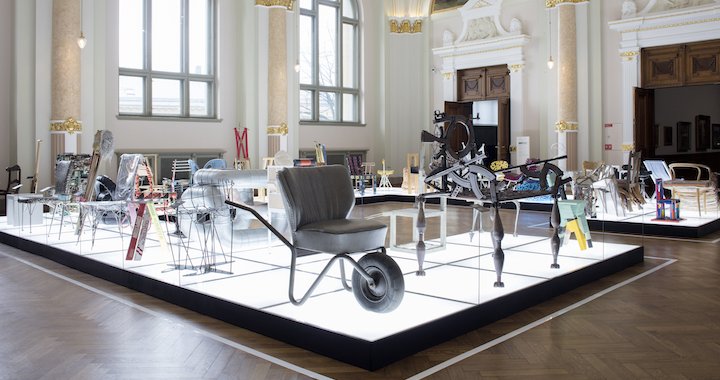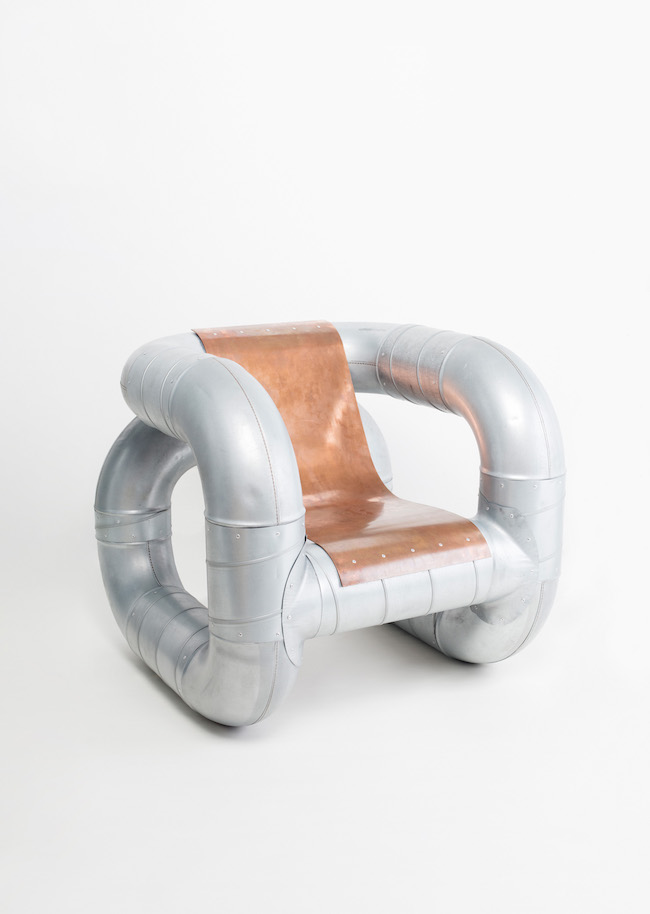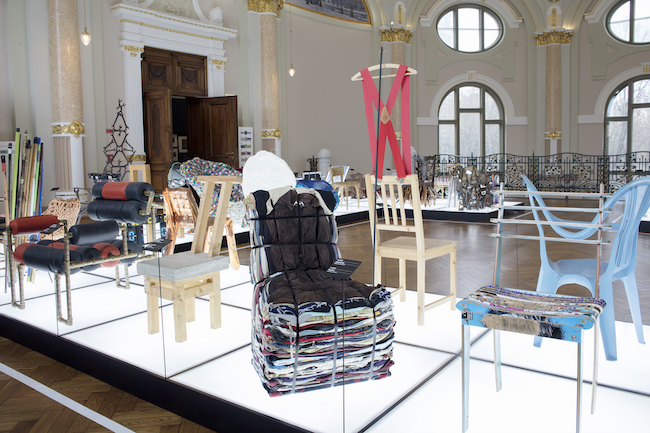
The Chair as Artwork
Exhibition the Chair as Artwork
10/04/2019
The Latvian National Museum of Art is hosting the exhibition The Chair as Artwork. Galila's Collection, Belgium from 11 April until 12 May 2019. The exhibition is situated in the lobby on the 3rd floor of the main building of the Latvian National Museum of Art, and is organised by the art and culture portal “Arterritory.com” as a collateral project of the Purvītis Prize 2019.
The Chair as Artwork: Galila's Collection, Belgium focuses on the manifold character of the chair, which has made this seemingly common, everyday object such a source for creative inspiration and experimentation. 50 chairs from Belgian collector Galila Barzilaï-Hollander’s collection are on view, the authors being artists, designers and architects, both well-established and those still young and emerging. Indeed they are based all around the globe, from France, Germany, Great Britain and Belgium to Senegal, Lebanon, Israel and South Korea.

Exhibition view. Photo: Kristīne Madjare
...In December 1888, Vincent van Gogh immortalised two chairs in two different paintings: his own and that of his fellow genius Paul Gauguin. These works later became a symbol of the relationship between these two artists. Gauguin had arrived in Arles to visit Van Gogh, and for eight weeks the two shared a studio in the city’s legendary Yellow House. This was a very creative period for Van Gogh, and in Gauguin’s company he created a painting a day. However, given the conceptual differences in the views of the two artists, as well as their different approaches to the creative process, their relationship soon took on a fairly destructive tone, culminating in Van Gogh’s infamous fit of insanity.
Painted on one of the canvases Gauguin had brought him, the image of Van Gogh’s chair feels empty and sad. Its owner has seemingly abandoned his chair, leaving only a pipe and tobacco pouch on it – intimate links to the person who once used this piece of furniture on a daily basis. Gauguin’s chair, on the other hand, is fancier, with armrests and curved legs; it stands on an ornate rug and seems to expansively move outward from the frame. A candle and two books have been placed on the chair. At exhibitions and in books, Gauguin’s chair is usually placed on the left, conspicuously turned away from Van Gogh’s chair, thereby accenting the men’s strained relationship. Both paintings have been interpreted countless times, both from a populist and analytically theoretical perspective.
Joseph Beuys’ Fat Chair (1964) has often been compared to Van Gogh’s chair. It is a sculptural object made of a simple, used wooden chair and a thick layer of fat – a favourite material of the artist – spread across the seat like a huge slice of cake or yeast. The German name of this chair, Fettstuhl, is a play on the double meaning of the word Stuhl, which can refer to both ‘chair’ and ‘faeces’. At the same time, it represents and uniquely frames the anatomy of its user, the human: intestines, sexuality, bodily fluids and organ systems.

Exhibition view. Photo: Kristīne Madjare
“The fundamental aspect is undeniably present in the chair as object. Stability. Roots. Of all kinds: ethnic, linguistic, country of residence, genealogy. When you build a house, you first lay the foundation. In a way, the chair symbolises this foundation. At the same time, it is an instrument of communication. It invites us to sit down and begin a conversation. The chair is also a symbol of power – for good reason, one of the oldest interpretations of a chair is the throne,” says Belgian art collector Galila Barzilaï-Hollander.
Her collection of chairs makes up only one part of her art collection, which contains a total of more than one thousand objects. But it is definitely one of the most expansive parts of the collection, vividly confirming that the chair as medium has no limits. The chair is humankind’s closest comrade from the world of objects. It is a tool for contemplation as well as communication. Ever since Homo sapiens learned to control fire and first sat down on an improvised seat, the chair has evolved in step with humans. It embodies understanding and support, power and status, the creation and taking away of life, torture and execution.

Exhibition view. Photo: Kristīne Madjare
Just as the chair can tell us about humans, it can also shed light on the world of things, including politics and esoterics, love and hate, art and daily life. The chair is not limited by choice of material; it can be made of practically anything. Perhaps this is why the chair as an object has always fascinated artists, designers and art theoreticians – from the aforementioned Van Gogh to Andy Warhol and Robert Rauschenberg. For example, artist and theoretician Joseph Kosuth used the chair as an object through which to begin a conversation about the concept and understanding of art.

Exhibition view. Photo: Kristīne Madjare
The chair provokes us to think. By creating seemingly functional and comfortable conditions, it invites us to take a journey of the imagination outside our comfort zone. As confirmed by Barzilaï-Hollander’s collection, the chair is able to be as diverse as the world itself, and thus also to a certain extent become a metaphor for the world.
Barzilaï-Hollander describes her approach to collecting as a union of unconsciousness and aesthetics. “I’ve never sought out chairs on which to sit,” she says. “I’ve always been more interested in the sculptural aspect of their essence, the visual mark they leave. I do not have chairs of a classic design in my collection; they all embody this merging of art and craft, and they are all absolutely creative objects. Each of them is different and has its own personal story.”
 Lucas Munoz. TUBULAR - Chair. Ventilation tubes, copper.
Lucas Munoz. TUBULAR - Chair. Ventilation tubes, copper.
Asked what it is that fascinates us about the chair as an object, one of the creators represented in the exhibition – Spanish artist, designer and craftsman Lucas Munoz – replies: “There is an anthropomorphic connection to chairs – they actually look like a person: bent knees and extended arms that reach the ground. They are a silhouette of the frontier between standing and falling, the thin red line that limits the borders of our balance. The closest furniture piece to us and, therefore, an enabler of many other furniture functions. All kinds of rituals happen around and on top of chairs, being the silent witnesses of our actions and rest. There is a design question that we all confront: Why another chair? The solution might come not from its quantity but from its quality(ies). I think, in this case, Galila's curiosity towards this object responds to these qualities and the enormous variations they comprehend. Out of all functional domestic objects, the chair has to fit to our body almost seamlessly, and we have so many bodies! It becomes a close object that almost fits to our soul, and what a chair sometimes seems to be talking about is that: the soul. It is an almost humanised artificial entity. The chair is there, and it waits for you to look at it.”

Johnny Swing. 1/4 dollar chair. 2002. Coins.
Likewise, American artist Johnny Swing asserts that “furniture, like architecture, is essential sculpture. It gives the creator a tremendous advantage because of its necessity. Like good architecture, a successful chair is more than a chair; it becomes an object of transformation. Transformational in two ways: one, as an object; and secondly, in its use and concern by the viewer/sitter. As an object, to be successful, I think that my work needs to be more; more than what? First, more than a board with 4 legs, because then it would be a stool. It needs a back, which starts to create some complex architecture problems. How do we get up to the back from this flat surface of the stool and what then needs to change with the flat surface when the back is added, so that the sitter doesn’t slide off when they lean back. Ok, wonderful – I just defined a chair vs a stool; that being said, it still has to be more. More what? – more than four legs, a seat and a backrest. But why? Because this is an opportunity to make something that has been made before, differently. The formula has been the same since before the wheel. Actually, the wheel never ended up becoming an art object but the chair certainly did; the chair is not only a place for contemplation – it became an object of contemplation itself. With my work, you can enjoy the shapes while in the work or as a passerby. I feel I have a responsibility to the chair and the viewer/sitter to offer more than a comfortable spot; I feel that I should be creating a dream. A place so seductive and relaxing that one’s mind can go to other places. Other places not of my direction but as access points for the viewer’s/interactor’s mind to wander. The work can be approached formally with regards to the materials and the technology involved in their construction or the shapes as sensual objects or magical cloud like forms. These are all starting points of success for me because they have and are pushing beyond just the seat with back support and maybe some legs, maybe no legs. Actually, it’s still a chair with no legs.”

Réjean Peytavin. Chair BTP. 2012. Wood, concrete.
It is precisely the chair’s “normalcy” that creates the greatest challenge, believes French designer Réjean Peytavin: “This very «normal» condition makes a chair fascinating, because it gives it a strong hidden psychologic side. Some other objects have the same power. A teacup can be seen like a poison container, a pen like a weapon.
The availability of an empty chair is the most welcoming idea on earth, and at the opposite, a dirty chair can be really awkward. Some industrial manufactures simply remove chairs in order to improve productivity. In these contexts, chairs appear as a non-productive and laziness symbol.
So a chair conveys many different ideas, which gives it a huge aura.
For me, a chair is an extension of the human body, a prothesis, and it is made to bring a primary comfort. I mean, the fact of sitting is the really first comfort. The chair is the tool that your body will naturally always look for; a place to sit. As you are sitting, the chair allows you to be located in space and offers you a stabilised point of outlook on your surroundings.

Exhibition view. Photo: Kristīne Madjare
So, bringing comfort and perspective, a chair becomes a thinking-improver. (..) It is kind of convenient to say that, but the challenge with a chair is to go beyond the chair. Keeping its complete system, the media chair has to outweigh its basic definitions and cross all the layers inflicted by consumerism and society, to maybe reach a spiritual and social lecture.”
It is this aspect that the exhibition’s architect, Latvian artist Krišs Salmanis, has accented. An illuminated, matte glass floor inspired by Stanley Kubrick’s legendary film 2001: A Space Odyssey serves as the exhibition’s main architectural element and creates the impression that these fifty chairs, or works of art, have just landed on this “pedestal” like an extravagant horde of extraterrestrials. Self-sufficient, inspiring, and full of creative madness. They thus provide a two-fold experience for visitors: the chance to view the installation as a whole and, thanks to the illuminated floor, to also examine each individual chair in detail and in its full artistic refinement. At the same time, they reaffirm the fact that there’s nothing more ambiguous than an empty chair – it embodies just as vivid a metaphor of the past as of the eventual future.

Along with the exhibition, the catalogue The Chair as Artwork. Galila’s Collection, Belgium, assembled by Krišs Salmanis, contains an interview with Galila Barzilaï-Hollander as well as descriptions of all fifty chairs and their creators.
Participating artists: Bokkinga Sander, Ericson Johanna, Vanlian Vick, Munoz Lucas, Lee Kwangho, Marcon Marco, Vuerich Baptiste, Moises David, Swing Johnny, Remy Terjo, Regis-R, Fatoumata Ba Amadou, Rollins Caldwell Benjamin, Pagart Remy, Madabe Adam, Dumont Henri-Francois, Hjorth Eva, Linke Kai, Morellet Francois, Luiz Philippe, Fouts Nancy, Vanden Eynde Maarten, Lane Danny, Mayor Julian, Peytavin Rejan, Zieta Oskar, Bohlin Jonas, Studio Job, West Franz, Arturo Felipe, Arnaud Eubelen, Borkenhagen Florian, Aran Ron, Dennier Boris, Price Tom, Bering Marcus, Rucli David, Heinz Julien, Burstein Eyal, Barzier - Jones Mark, Pesce Getano, Hans Peter Feldmann.
ARCHIVE: An interview with Belgian art collector Galila Barzilaï Hollander